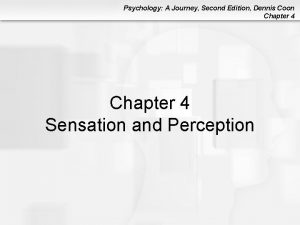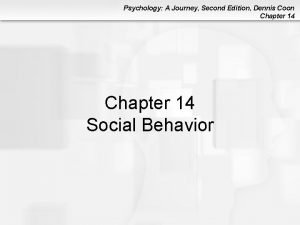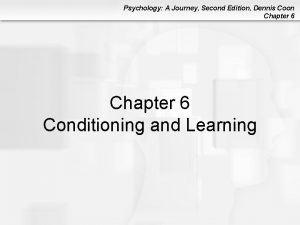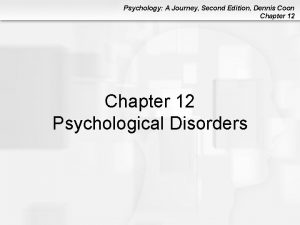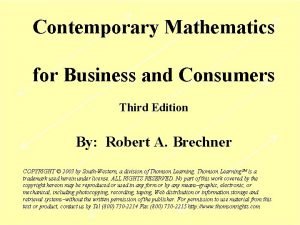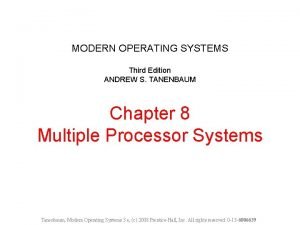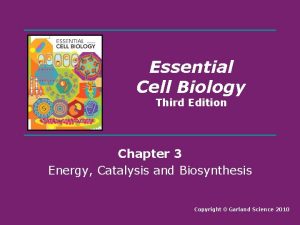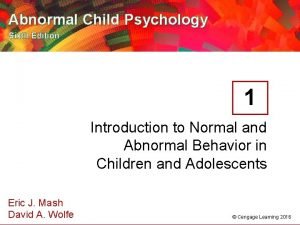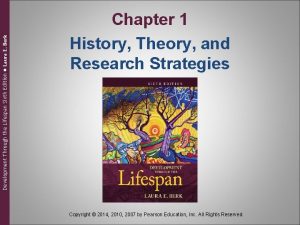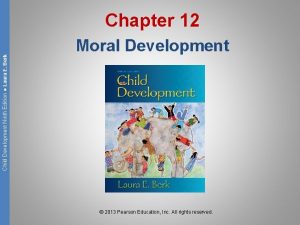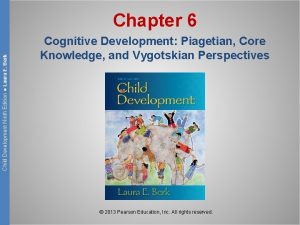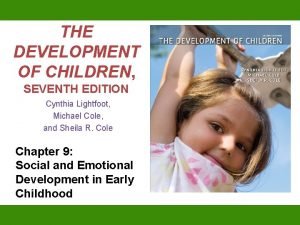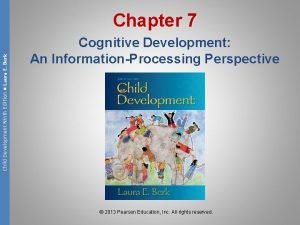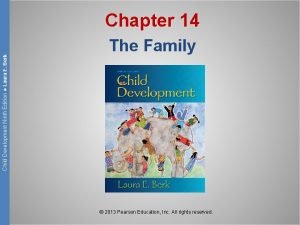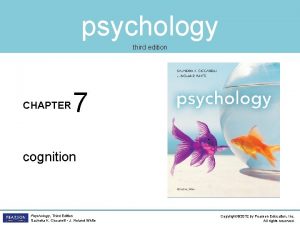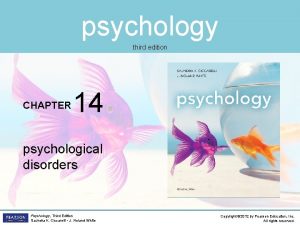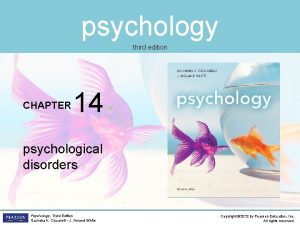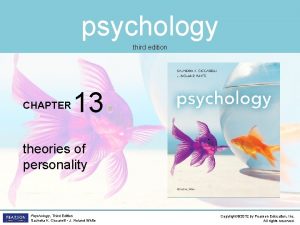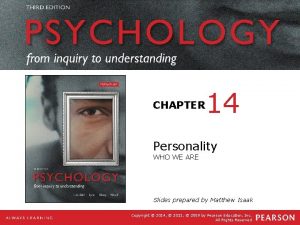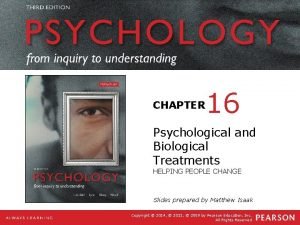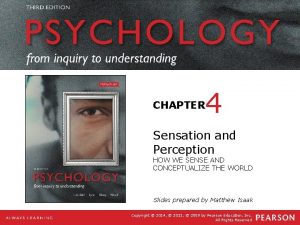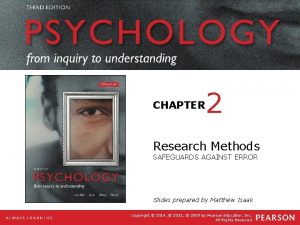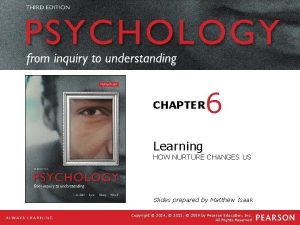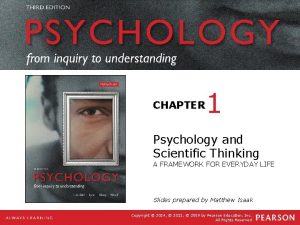psychology third edition CHAPTER 8 development across the




































































- Slides: 68

psychology third edition CHAPTER 8 development across the life span Psychology, Third Edition Saundra K. Ciccarelli • J. Noland White Copyright © 2012 by Pearson Education, Inc. All rights reserved.

Learning Objective Menu • • LO 8. 1 LO 8. 2 LO 8. 3 LO 8. 4 LO 8. 5 LO 8. 6 LO 8. 7 • LO 8. 8 • • • LO 8. 9 LO 8. 10 LO 8. 11 Special Research Methods Used to Study Development The Relationship between Heredity and Environmental Factors Chromosomes, Genes, DNA, and Multiple Births Germinal, Embryonic, and Fetal Periods of Pregnancy Physical Changes in Infancy and Childhood Looking at Cognitive Development and How Language Develops Developing Personalities, Forming Relationships, and Erikson’s First Four Stages of Psychosocial Development How Adolescents Develop Formal Operation, Moral Thinking, and the Adolescent’s Search for Identity Physical and Cognitive Changes during Adulthood and Aging Theories of Why Aging Occurs and Stages of Death and Dying Some Cross-Cultural Differences in Views of Death and Dying Psychology, Third Edition Saundra K. Ciccarelli • J. Noland White Copyright © 2012 by Pearson Education, Inc. All rights reserved.

Psychology, Third Edition Saundra K. Ciccarelli • J. Noland White Copyright © 2012 by Pearson Education, Inc. All rights reserved.

Developmental Research Designs LO 8. 1 Special Research Methods Used to Study Development • Human development: the scientific study of the changes that occur in people as they age from conception until death • Longitudinal design: research design in which one participant or group of participants is studied over a long period of time Psychology, Third Edition Saundra K. Ciccarelli • J. Noland White Copyright © 2012 by Pearson Education, Inc. All rights reserved.

Longitudinal Design Tested at 1 year (Time 1) Psychology, Third Edition Saundra K. Ciccarelli • J. Noland White Again at 4 years (Time 2) Again at 7 years (Time 3) Copyright © 2012 by Pearson Education, Inc. All rights reserved.

Longitudinal Design Compare Tested at 1 year (Time 1) Compare Again at 4 years (Time 2) Again at 7 years (Time 3) Same Participants Different Times Psychology, Third Edition Saundra K. Ciccarelli • J. Noland White Different Times Copyright © 2012 by Pearson Education, Inc. All rights reserved.

Developmental Research Designs LO 8. 1 Special Research Methods Used to Study Development • Cross-sectional design: research design in which several different age groups of participants are studied at one particular point in time • Cross-sequential design: research design in which participants are first studied by means of a cross-sectional design but also followed and assessed for a period of no more than six years Psychology, Third Edition Saundra K. Ciccarelli • J. Noland White Copyright © 2012 by Pearson Education, Inc. All rights reserved.

Nature versus Nurture LO 8. 2 The Relationship between Heredity and Environmental Factors • Nature: the influence of our inherited characteristics on our personality, physical growth, intellectual growth, and social interactions • Nurture: the influence of the environment on personality, physical growth, intellectual growth, and social interactions • Behavioral genetics: focuses on nature vs. nurture Psychology, Third Edition Saundra K. Ciccarelli • J. Noland White Copyright © 2012 by Pearson Education, Inc. All rights reserved.

Genetics and Development LO 8. 3 Chromosomes, Genes, DNA, and Multiple Births • Genetics: the science of inherited traits • DNA (deoxyribonucleic acid): special molecule that contains the genetic material of the organism Psychology, Third Edition Saundra K. Ciccarelli • J. Noland White Copyright © 2012 by Pearson Education, Inc. All rights reserved.

Figure 8. 1 DNA Molecule In this model of a DNA molecule, the two strands making up the sides of the “twisted ladder” are composed of sugars and phosphates. The “rungs” of the ladder that link the two strands are amines. Amines contain the genetic codes for building the proteins that make up organic life. Psychology, Third Edition Saundra K. Ciccarelli • J. Noland White Copyright © 2012 by Pearson Education, Inc. All rights reserved.

Genetics and Development LO 8. 3 Chromosomes, Genes, DNA, and Multiple Births • Gene: section of DNA having the same arrangement of chemical elements – dominant: referring to a gene that actively controls the expression of a trait – recessive: referring to a gene that only influences the expression of a trait when paired with an identical gene Psychology, Third Edition Saundra K. Ciccarelli • J. Noland White Copyright © 2012 by Pearson Education, Inc. All rights reserved.

Figure 8. 2 Dominant and Recessive Genes and PKU This figure shows the variation of parents carrying one or two recessive genes and the result of this in their offspring. (a) If only one parent carries the PKU gene, their children might be carriers, but will not have PKU. Psychology, Third Edition Saundra K. Ciccarelli • J. Noland White Copyright © 2012 by Pearson Education, Inc. All rights reserved.

Figure 8. 2 (continued) Dominant and Recessive Genes and PKU This figure shows the variation of parents carrying one or two recessive genes and the result of this in their offspring. (b) Only if both parents are carriers of PKU will a child have the 1 in 4 possibility of having PKU. Psychology, Third Edition Saundra K. Ciccarelli • J. Noland White Copyright © 2012 by Pearson Education, Inc. All rights reserved.

Mendel Box LO 8. 3 Chromosomes, Genes, DNA, and Multiple Births • B=Brown eyes b=Blue eyes Psychology, Third Edition Saundra K. Ciccarelli • J. Noland White Copyright © 2012 by Pearson Education, Inc. All rights reserved.

Mendel Box LO 8. 3 Chromosomes, Genes, DNA, and Multiple Births • B=Brown eyes b=Blue eyes Psychology, Third Edition Saundra K. Ciccarelli • J. Noland White Copyright © 2012 by Pearson Education, Inc. All rights reserved.

Mendel Box LO 8. 3 Chromosomes, Genes, DNA, and Multiple Births • B=Brown eyes b=Blue eyes Psychology, Third Edition Saundra K. Ciccarelli • J. Noland White Copyright © 2012 by Pearson Education, Inc. All rights reserved.

Mendel Box LO 8. 3 Chromosomes, Genes, DNA, and Multiple Births • B=Brown eyes b=Blue eyes Psychology, Third Edition Saundra K. Ciccarelli • J. Noland White Copyright © 2012 by Pearson Education, Inc. All rights reserved.

Mendel Box LO 8. 3 Chromosomes, Genes, DNA, and Multiple Births • 75% have brown eyes. 25% have blue eyes. Psychology, Third Edition Saundra K. Ciccarelli • J. Noland White Copyright © 2012 by Pearson Education, Inc. All rights reserved.

Genetics and Development LO 8. 3 Chromosomes, Genes, DNA, and Multiple Births • Chromosome: tightly wound strand of genetic material or DNA • Chromosome disorders include Down syndrome, Klinefelter’s syndrome, and Turner’s syndrome, whereas genetic disorders include PKU, cystic fibrosis, sickle cell anemia, and Tay-Sachs disease. Psychology, Third Edition Saundra K. Ciccarelli • J. Noland White Copyright © 2012 by Pearson Education, Inc. All rights reserved.

Genetics and Development LO 8. 3 Chromosomes, Genes, DNA, and Multiple Births • Conception: the moment at which a female becomes pregnant • Ovum: the female sex cell, or egg • Fertilization: the union of the ovum and sperm • Zygote: cell resulting from the uniting of the ovum and sperm; divides into many cells, eventually forming the baby Psychology, Third Edition Saundra K. Ciccarelli • J. Noland White Copyright © 2012 by Pearson Education, Inc. All rights reserved.

Conception and Twins LO Chromosomes, Genes, DNA, and Multiple Births • Monozygotic twins: identical twins; formed when one zygote splits into two separate masses of cells, each of which develops into a separate embryo • Dizygotic twins: often called fraternal twins; occurs when two eggs each get fertilized by two different sperm, resulting in two zygotes in the uterus at the same time. Psychology, Third Edition Saundra K. Ciccarelli • J. Noland White Copyright © 2012 by Pearson Education, Inc. All rights reserved.

Figure 8. 3 Monozygotic and Dizygotic Twins Because identical twins come from one fertilized egg (zygote), they are called monozygotic. Fraternal twins, who come from two different fertilized eggs, are called dizygotic. Psychology, Third Edition Saundra K. Ciccarelli • J. Noland White Copyright © 2012 by Pearson Education, Inc. All rights reserved.

Periods of Pregnancy LO 8. 4 Germinal, Embryonic, and Fetal Periods of Pregnancy • Germinal period: first two weeks after fertilization, during which the zygote moves down to the uterus and begins to implant in the lining; embryo is the name for the developing organism from two weeks to eight weeks after fertilization Psychology, Third Edition Saundra K. Ciccarelli • J. Noland White Copyright © 2012 by Pearson Education, Inc. All rights reserved.

Periods of Pregnancy LO 8. 4 Germinal, Embryonic, and Fetal Periods of Pregnancy • Embryonic period: the period from two to eight weeks after fertilization, during which the major organs and structures of the organism develop – critical periods: times during which certain environmental influences can have an impact on the development of the infant – teratogen: any factor that can cause a birth defect Psychology, Third Edition Saundra K. Ciccarelli • J. Noland White Copyright © 2012 by Pearson Education, Inc. All rights reserved.

Psychology, Third Edition Saundra K. Ciccarelli • J. Noland White Copyright © 2012 by Pearson Education, Inc. All rights reserved.

Periods of Pregnancy LO 8. 4 Germinal, Embryonic, and Fetal Periods of Pregnancy • Fetal period: the time from about eight weeks after conception until the birth of the child – fetus: name for the developing organism from eight weeks after fertilization to the birth of the baby Psychology, Third Edition Saundra K. Ciccarelli • J. Noland White Copyright © 2012 by Pearson Education, Inc. All rights reserved.

Figure 8. 4 Five Infant Reflexes Shown here are (a) grasping reflex; (b) startle reflex (also known as the Moro reflex); (c) rooting reflex (when you touch a baby‘s cheek it will turn toward your hand, open its mouth, and search for the nipple); Psychology, Third Edition Saundra K. Ciccarelli • J. Noland White Copyright © 2012 by Pearson Education, Inc. All rights reserved.

Figure 8. 4 (continued) Five Infant Reflexes (d) stepping reflex; and (e) sucking reflex. These infant reflexes can be used to check the health of an infant’s nervous system. If a reflex is absent or abnormal, it may indicate brain damage or some other neurological problem. Psychology, Third Edition Saundra K. Ciccarelli • J. Noland White Copyright © 2012 by Pearson Education, Inc. All rights reserved.

Figure 8. 6 Six Motor Milestones Shown here are (a) raising head and chest— 2 to 4 months, (b) rolling over— 2 to 5 months, (c) sitting up with support— 4 to 6 months, Psychology, Third Edition Saundra K. Ciccarelli • J. Noland White Copyright © 2012 by Pearson Education, Inc. All rights reserved.

Figure 8. 6 (continued) Six Motor Milestones (d) sitting up without support— 6 to 7 months, (e) crawling— 7 to 8 months, and (f) walking— 8 to 18 months. The motor milestones develop as the infant gains greater voluntary control over the muscles in its body, typically from the top of the body downward. This pattern is seen in the early control of the neck muscles and the much later development of control of the legs and feet. Psychology, Third Edition Saundra K. Ciccarelli • J. Noland White Copyright © 2012 by Pearson Education, Inc. All rights reserved.

Physical Development in Infancy and Childhood LO 8. 5 Physical Changes in Infancy and Childhood • Four critical areas of adjustment for the newborn are: – respiration – digestion – circulation – temperature regulation • Infants are born with reflexes that help them survive: sucking, rooting, Moro (startle), grasping, and Babinski. reflexes Psychology, Third Edition Saundra K. Ciccarelli • J. Noland White Copyright © 2012 by Pearson Education, Inc. All rights reserved.

Physical Development in Infancy and Childhood LO 8. 5 Physical Changes in Infancy and Childhood • The senses, except for vision, are fairly well developed at birth. • Gross and fine motor skills develop at a fast pace during infancy and early childhood. Psychology, Third Edition Saundra K. Ciccarelli • J. Noland White Copyright © 2012 by Pearson Education, Inc. All rights reserved.

Immunizations LO 8. 5 Physical Changes in Infancy and Childhood • Immunizations are far less dangerous than the diseases they are designed to prevent, and are one of the most effective weapons in the fight against infectious diseases. Psychology, Third Edition Saundra K. Ciccarelli • J. Noland White Copyright © 2012 by Pearson Education, Inc. All rights reserved.

Cognitive Development LO 8. 6 Looking at Cognitive Development and How Language Develops • Cognitive development: the development of thinking, problem solving, and memory scheme (plural schemas), a mental concept formed through experiences with objects and events Psychology, Third Edition Saundra K. Ciccarelli • J. Noland White Copyright © 2012 by Pearson Education, Inc. All rights reserved.

Piaget’s Stage Theory LO 8. 6 Looking at Cognitive Development and How Language Develops • Sensorimotor stage: Piaget’s first stage of cognitive development, in which the infant uses its senses and motor abilities to interact with objects in the environment – object permanence: the knowledge that an object exists even when it is not in sight – Stewie and Object Permanence Psychology, Third Edition Saundra K. Ciccarelli • J. Noland White Copyright © 2012 by Pearson Education, Inc. All rights reserved.

Psychology, Third Edition Saundra K. Ciccarelli • J. Noland White Copyright © 2012 by Pearson Education, Inc. All rights reserved.

Figure 8. 7 Conservation Experiment A typical conservation task consists of pouring equal amounts of water into two glasses of the same size and shape. When the water from one of these glasses is poured into a taller, narrower glass, children who cannot yet conserve tend to focus (centrate) on the height of the water in the second glass, assuming that the second glass now has more water than the first one. In the second example, pennies are laid out in two equal lines. When the pennies in the top line are spaced out, the child who cannot yet conserve will centrate on the top line and assume that there actually more pennies in that line. Psychology, Third Edition Saundra K. Ciccarelli • J. Noland White Copyright © 2012 by Pearson Education, Inc. All rights reserved.

Piaget’s Stage Theory LO 8. 6 Looking at Cognitive Development and How Language Develops • Preoperational stage: Piaget’s second stage of cognitive development, in which the preschool child learns to use language as a means of exploring the world – egocentrism: the inability to see the world through anyone else’s eyes example – centration: in Piaget’s theory, the tendency of a young child to focus only on one feature of an object while ignoring other relevant features Psychology, Third Edition Saundra K. Ciccarelli • J. Noland White Copyright © 2012 by Pearson Education, Inc. All rights reserved.

Piaget’s Stage Theory LO 8. 6 Looking at Cognitive Development and How Language Develops • Preoperational Stage (cont’d) – conservation: in Piaget’s theory, the ability to understand that simply changing the appearance of an object does not change the object’s nature conservation – irreversibility: in Piaget’s theory, the inability of the young child to mentally reverse an action Psychology, Third Edition Saundra K. Ciccarelli • J. Noland White Copyright © 2012 by Pearson Education, Inc. All rights reserved.

Piaget’s Stage Theory LO 8. 6 Looking at Cognitive Development and How Language Develops • Concrete operations stage: third stage of cognitive development. in which the school -aged child becomes capable of logical thought processes but is not yet capable of abstract thinking • Formal operations: Piaget’s last stage of cognitive development, in which the adolescent becomes capable of abstract thinking Psychology, Third Edition Saundra K. Ciccarelli • J. Noland White Copyright © 2012 by Pearson Education, Inc. All rights reserved.

Vygotsky’s Theory LO 8. 6 Looking at Cognitive Development and How Language Develops • Russian Psychologist Lev Vygotsky’s ideas were originally suppressed by the Soviet government but have since gained a following around the world • Scaffolding: process in which a more skilled learner gives help to a less skilled learner, reducing the amount of help as the less skilled learner becomes more capable Psychology, Third Edition Saundra K. Ciccarelli • J. Noland White Copyright © 2012 by Pearson Education, Inc. All rights reserved.

Vygotsky’s Theory LO 8. 6 Looking at Cognitive Development and How Language Develops • Zone of proximal development (ZPD): Vygotsky’s concept of the difference between what a child can do alone and what that child can do with the help of a teacher • His ideas have been put into practice in education through the use of cooperative learning. • Group work with an emphasis on common goals and reciprocal teaching is indicative of Vygotsky’s theory. Psychology, Third Edition Saundra K. Ciccarelli • J. Noland White Copyright © 2012 by Pearson Education, Inc. All rights reserved.

Stages of Language Development LO 8. 6 Looking at Cognitive Development and How Language Develops • Cooing-at about 2 months of age, babies begin to make vowel-like sounds • Babbling-at about 6 months of age, babies add consonants sounds to the vowels. • One-Word Speech (Holophrases)-around the age of 1, most children start to say actual words, e. g. “Milk!” might mean “I want milk. ” Psychology, Third Edition Saundra K. Ciccarelli • J. Noland White Copyright © 2012 by Pearson Education, Inc. All rights reserved.

Stages of Language Development • Telegraphic Speech-At around a year and a half, toddlers start forming short, simple sentences using nouns, verb, and adjectives. “Me go bye-bye. ” • Whole Sentences-As children mature they gain grammar, and increase the number of words in their sentence. By the age of 6 they are almost as fluent as an adult. Psychology, Third Edition Saundra K. Ciccarelli • J. Noland White Copyright © 2012 by Pearson Education, Inc. All rights reserved.

Noam Chomsky-Language Acqusition Device • Chomsky disputes Skinnerian principles of reinforcement in the learning of language. • Chomsky believes that we are born with an innate ability to learn language and therefore language develops along a well researched sequence. Psychology, Third Edition Saundra K. Ciccarelli • J. Noland White Copyright © 2012 by Pearson Education, Inc. All rights reserved.

Temperament LO 8. 7 Developing Personalities, Forming Relationships, and Erikson’s First Four Stages of Psychosocial Development • Temperament: the behavioral characteristics that are fairly well established at birth (Chess & Thomas, 1986) – easy: regular, adaptable, and happy – difficult: irregular, nonadaptable, and irritable – slow to warm up: need to adjust gradually to change – Harlow Psychology, Third Edition Saundra K. Ciccarelli • J. Noland White Copyright © 2012 by Pearson Education, Inc. All rights reserved.

Attachment LO 8. 7 Developing Personalities, Forming Relationships, and Erikson’s First Four Stages of Psychosocial Development • Attachment: the emotional bond between an infant and the primary caregiver (Mary Ainsworth, 1985) – secure: willing to explore; upset when mother departs, but easily soothed upon her return – avoidant: unattached; explores without “touching base” – ambivalent: insecurely attached; upset when mother leaves and then angry with mother upon her return Psychology, Third Edition Saundra K. Ciccarelli • J. Noland White Copyright © 2012 by Pearson Education, Inc. All rights reserved.

Attachment LO 8. 7 Developing Personalities, Forming Relationships, and Erikson’s First Four Stages of Psychosocial Development • Attachment (cont’d) – Disorganized-disoriented: insecurely attached and sometimes abused or neglected; child seems fearful, dazed, and depressed – Ainsworth Psychology, Third Edition Saundra K. Ciccarelli • J. Noland White Copyright © 2012 by Pearson Education, Inc. All rights reserved.

Erikson’s First Four Stages LO 8. 7 Developing Personalities, Forming Relationships, and Erikson’s First Four Stages of Psychosocial Development • Trust versus mistrust: first stage of personality development, in which the infant’s basic sense of trust or mistrust develops as a result of consistent or inconsistent care • Autonomy versus shame and doubt: second stage of personality development, in which the toddler strives for physical independence Psychology, Third Edition Saundra K. Ciccarelli • J. Noland White Copyright © 2012 by Pearson Education, Inc. All rights reserved.

Erikson’s First Four Stages LO 8. 7 Developing Personalities, Forming Relationships, and Erikson’s First Four Stages of Psychosocial Development • Initiative versus guilt: third stage of personality development, in which the preschool-aged child strives for emotional and psychological independence and attempts to satisfy curiosity about the world Psychology, Third Edition Saundra K. Ciccarelli • J. Noland White Copyright © 2012 by Pearson Education, Inc. All rights reserved.

Erikson’s First Four Stages LO 8. 7 Developing Personalities, Forming Relationships, and Erikson’s First Four Stages of Psychosocial Development • Industry versus inferiority: fourth stage of personality development, in which the adolescent strives for a sense of competence and self-esteem Psychology, Third Edition Saundra K. Ciccarelli • J. Noland White Copyright © 2012 by Pearson Education, Inc. All rights reserved.

Psychology, Third Edition Saundra K. Ciccarelli • J. Noland White Copyright © 2012 by Pearson Education, Inc. All rights reserved.

Table 8. 4 (continued) Erikson’s Psychosocial Stages of Development Psychology, Third Edition Saundra K. Ciccarelli • J. Noland White Copyright © 2012 by Pearson Education, Inc. All rights reserved.

Gender Role Development LO 8. 7 Developing Personalities, Forming Relationships, and Erikson’s First Four Stages of Psychosocial Development • Gender: the behavior associated with being male or female • Gender identity: perception of one’s gender and the behavior that is associated with that gender Psychology, Third Edition Saundra K. Ciccarelli • J. Noland White Copyright © 2012 by Pearson Education, Inc. All rights reserved.

Puberty and Adolescence LO 8. 8 How Adolescents Develop Formal Operation, Moral Thinking, and the Adolescent’s Search for Identity • Adolescence: the period of life from about age thirteen to the early twenties, during which a young person is no longer physically a child but is not yet an independent, self-supporting adult • Puberty: the physical changes that occur in the body as sexual development reaches its peak – period of about four years Psychology, Third Edition Saundra K. Ciccarelli • J. Noland White Copyright © 2012 by Pearson Education, Inc. All rights reserved.

Egocentric Thinking LO 8. 8 How Adolescents Develop Formal Operation, Moral Thinking, and the Adolescent’s Search for Identity • Personal fable: type of thought common to adolescents in which young people believe themselves to be unique and protected from harm Psychology, Third Edition Saundra K. Ciccarelli • J. Noland White Copyright © 2012 by Pearson Education, Inc. All rights reserved.

Egocentric Thinking LO 8. 8 How Adolescents Develop Formal Operation, Moral Thinking, and the Adolescent’s Search for Identity • Imaginary audience: type of thought common to adolescents in which young people believe that other people are just as concerned about the adolescent’s thoughts and characteristics as they themselves are Psychology, Third Edition Saundra K. Ciccarelli • J. Noland White Copyright © 2012 by Pearson Education, Inc. All rights reserved.

Development of Morality LO 8. 8 How Adolescents Develop Formal Operation, Moral Thinking, and the Adolescent’s Search for Identity • Preconventional morality: first level of Kohlberg’s stages of moral development, in which the child’s behavior is governed by the consequences of the behavior • Conventional morality: second level of Kohlberg’s stages of moral development, in which the child’s behavior is governed by conforming to society’s norms of behavior Psychology, Third Edition Saundra K. Ciccarelli • J. Noland White Copyright © 2012 by Pearson Education, Inc. All rights reserved.

Development of Morality LO 8. 8 How Adolescents Develop Formal Operation, Moral Thinking, and the Adolescent’s Search for Identity • Postconventional morality: third level of Kohlberg’s stages of moral development. in which the person’s behavior is governed by moral principles that have been decided on by the individual and which may be in disagreement with accepted social norms Psychology, Third Edition Saundra K. Ciccarelli • J. Noland White Copyright © 2012 by Pearson Education, Inc. All rights reserved.

Figure 8. 8 Example of a Moral Dilemma Source: Kohlberg, 1969, p. 379. Psychology, Third Edition Saundra K. Ciccarelli • J. Noland White Copyright © 2012 by Pearson Education, Inc. All rights reserved.

Psychology, Third Edition Saundra K. Ciccarelli • J. Noland White Copyright © 2012 by Pearson Education, Inc. All rights reserved.

Erikson’s Fifth Stage LO 8. 8 How Adolescents Develop Formal Operation, Moral Thinking, and the Adolescent’s Search for Identity • Fifth stage of personality development, in which the adolescent must find a consistent sense of self (Identity vs. Role Confusion) • Peer pressure is quite effective on teenagers who want to “fit in” and have an identity of some sort Psychology, Third Edition Saundra K. Ciccarelli • J. Noland White Copyright © 2012 by Pearson Education, Inc. All rights reserved.

Physical Changes and Aging LO 8. 9 Physical and Cognitive Changes during Adulthood and Aging • Adulthood begins in the early twenties and ends with death in old age. – divided into young adulthood, middle adulthood, and late adulthood Psychology, Third Edition Saundra K. Ciccarelli • J. Noland White Copyright © 2012 by Pearson Education, Inc. All rights reserved.

Physical Changes and Aging LO 8. 9 Physical and Cognitive Changes during Adulthood and Aging • Women experience a physical decline in the reproductive system called the climacteric, ending at about age fifty with menopause: the cessation of ovulation and menstrual cycles and the end of a woman’s reproductive capability. Psychology, Third Edition Saundra K. Ciccarelli • J. Noland White Copyright © 2012 by Pearson Education, Inc. All rights reserved.

Physical Changes and Aging LO 8. 9 Physical and Cognitive Changes during Adulthood and Aging • Andropause: gradual changes in the sexual hormones and reproductive system of males – increase in health problems, decrease in reaction time, and stability in intelligence and memory Psychology, Third Edition Saundra K. Ciccarelli • J. Noland White Copyright © 2012 by Pearson Education, Inc. All rights reserved.

Erikson’s Stage 6 -Intimacy v. Isolation LO 8. 9 Physical and Cognitive Changes during Adulthood and Aging • The task facing those in early adulthood is to be able to share who they are, with another person in a close, committed relationship. • Adults who fail at this task will be isolated from other people and may suffer from loneliness. Psychology, Third Edition Saundra K. Ciccarelli • J. Noland White Copyright © 2012 by Pearson Education, Inc. All rights reserved.

Erikson’s Stage 7 -Generativity vs. Stagnation • The challenge is to be creative, productive, and nurture the next generation. • Adults who fail will be passive, and selfcentered, feel that they have done nothing for the next generation, and feel that the world is no better off for their being alive. Psychology, Third Edition Saundra K. Ciccarelli • J. Noland White Copyright © 2012 by Pearson Education, Inc. All rights reserved.

Erikson’s Stage 8 -Ego Integrity vs. Despair • The issue is whether a person will reach wisdom, spiritual tranquility, a sense of wholeness, and acceptance of his or her life. • Elderly people who fail will feel that their life is empty and will fear death. Psychology, Third Edition Saundra K. Ciccarelli • J. Noland White Copyright © 2012 by Pearson Education, Inc. All rights reserved.
 Lifespan development third edition
Lifespan development third edition Lifespan development third edition
Lifespan development third edition Forward caries definition
Forward caries definition Mounts classification
Mounts classification Lazarus appraisal theory
Lazarus appraisal theory Psychology a journey 4th edition chapter 1
Psychology a journey 4th edition chapter 1 Psychology a journey 4th edition chapter 1
Psychology a journey 4th edition chapter 1 Psychology a journey 4th edition chapter 1
Psychology a journey 4th edition chapter 1 Psychology a journey
Psychology a journey Oxford fajar
Oxford fajar Organic chemistry third edition david klein
Organic chemistry third edition david klein Organic chemistry third edition david klein
Organic chemistry third edition david klein Business mathematics third edition
Business mathematics third edition Modern operating systems tanenbaum
Modern operating systems tanenbaum Fundamentals of corporate finance third canadian edition
Fundamentals of corporate finance third canadian edition Sujata madan
Sujata madan Essential cell biology chapter 1
Essential cell biology chapter 1 Joey's first 14 quiz grades in a marking period were
Joey's first 14 quiz grades in a marking period were Mis chapter 6
Mis chapter 6 Using mis (10th edition)
Using mis (10th edition) Altruism definition psychology
Altruism definition psychology Father of humanistic psychology
Father of humanistic psychology Patterns of development in writing across disciplines
Patterns of development in writing across disciplines Levels of analysis psychology
Levels of analysis psychology Psychology ninth edition in modules
Psychology ninth edition in modules Psychology eighth edition david g myers
Psychology eighth edition david g myers Abnormal child psychology 6th edition
Abnormal child psychology 6th edition Psychology
Psychology Lysanx
Lysanx Psychology ninth edition david g myers
Psychology ninth edition david g myers Social psychology ninth edition
Social psychology ninth edition Psychology tenth edition in modules
Psychology tenth edition in modules Psychology ninth edition in modules
Psychology ninth edition in modules Development through the lifespan 6th edition
Development through the lifespan 6th edition The development of children 7th edition
The development of children 7th edition Laura e berk child development 9th edition pdf
Laura e berk child development 9th edition pdf Child development berk 9th edition
Child development berk 9th edition Transductive reasoning psychology
Transductive reasoning psychology The development of children 7th edition
The development of children 7th edition Child development ninth edition
Child development ninth edition Child development ninth edition
Child development ninth edition Hình ảnh bộ gõ cơ thể búng tay
Hình ảnh bộ gõ cơ thể búng tay Ng-html
Ng-html Bổ thể
Bổ thể Tỉ lệ cơ thể trẻ em
Tỉ lệ cơ thể trẻ em Voi kéo gỗ như thế nào
Voi kéo gỗ như thế nào Glasgow thang điểm
Glasgow thang điểm Bài hát chúa yêu trần thế alleluia
Bài hát chúa yêu trần thế alleluia Các môn thể thao bắt đầu bằng tiếng chạy
Các môn thể thao bắt đầu bằng tiếng chạy Thế nào là hệ số cao nhất
Thế nào là hệ số cao nhất Các châu lục và đại dương trên thế giới
Các châu lục và đại dương trên thế giới Công thức tính thế năng
Công thức tính thế năng Trời xanh đây là của chúng ta thể thơ
Trời xanh đây là của chúng ta thể thơ Mật thư tọa độ 5x5
Mật thư tọa độ 5x5 Làm thế nào để 102-1=99
Làm thế nào để 102-1=99 Phản ứng thế ankan
Phản ứng thế ankan Các châu lục và đại dương trên thế giới
Các châu lục và đại dương trên thế giới Thơ thất ngôn tứ tuyệt đường luật
Thơ thất ngôn tứ tuyệt đường luật Quá trình desamine hóa có thể tạo ra
Quá trình desamine hóa có thể tạo ra Một số thể thơ truyền thống
Một số thể thơ truyền thống Cái miệng nó xinh thế chỉ nói điều hay thôi
Cái miệng nó xinh thế chỉ nói điều hay thôi Vẽ hình chiếu vuông góc của vật thể sau
Vẽ hình chiếu vuông góc của vật thể sau Biện pháp chống mỏi cơ
Biện pháp chống mỏi cơ đặc điểm cơ thể của người tối cổ
đặc điểm cơ thể của người tối cổ Giọng cùng tên là
Giọng cùng tên là Vẽ hình chiếu đứng bằng cạnh của vật thể
Vẽ hình chiếu đứng bằng cạnh của vật thể Tia chieu sa te
Tia chieu sa te Thẻ vin
Thẻ vin đại từ thay thế
đại từ thay thế





